

SEPTA HOMEPAGE
RAILFAN GUIDES HOME
RAILROAD SIGNALS HOME
The 101 and 102 routes are collectively known as the Media and Sharon Hill Lines because of their destinations. The 101 and 102 lines have been known by these destinations forever.
The Kawasaki K-cars used on these lines were delivered in the 1980-1982 timeframe, and there are around 29 of them in use on these two lines. They are considered LRV's, but remind you more of an updated streetcar or PCC car when you ride them. The shops for the cars are adjacent to the 69th St Transportation center, co-located with the Market-Frankford subway cars.
A couple of other interesting notes:
These two lines use pantographs on the cars instead of
the more traditional trolley poles used on the Surface Subway lines!
The cars are double ended because there are no loops on
either lines except for 69th Street.
Since the cars are
30+ years old, there is always talk about replacing them, but one of the things
that has kept SEPTA so far from doing so, is that they have been able SO FAR to
circumvent the ADA requirement for handicapped access. If they get new
cars, both lines will need to be upgraded, a very expensive proposition.
Also, keep in mind that when the cars get into Media, they run up the middle of
the street with no real station per se, further complicating the problem.
One thought is to stop service short of the downtown Media area. This is
all scuttlebutt right now, stuff you read in the paper, but something that will
have to be dealt with eventually as SEPTA brings the lines into the modern
era........
All pictures by Todd Sestero unless noted.
More info can be found at:
At the 69th St Terminal (Transportation Center) At Drexel Hill Junction
Around the system
http://en.wikipedia.org/wiki/SEPTA_Routes_101_and_102
http://www.septa.org/maps/trolley/city.html
http://philadelphiaencyclopedia.org/archive/streetcars/
https://ceramembersblog.wordpress.com/2013/05/06/septa-red-car-media-trolley-fantrip/
http://www.phillytrolley.org/redarrow.html
http://www.phillytrolley.org/1980Kcars/1980Kcars.html
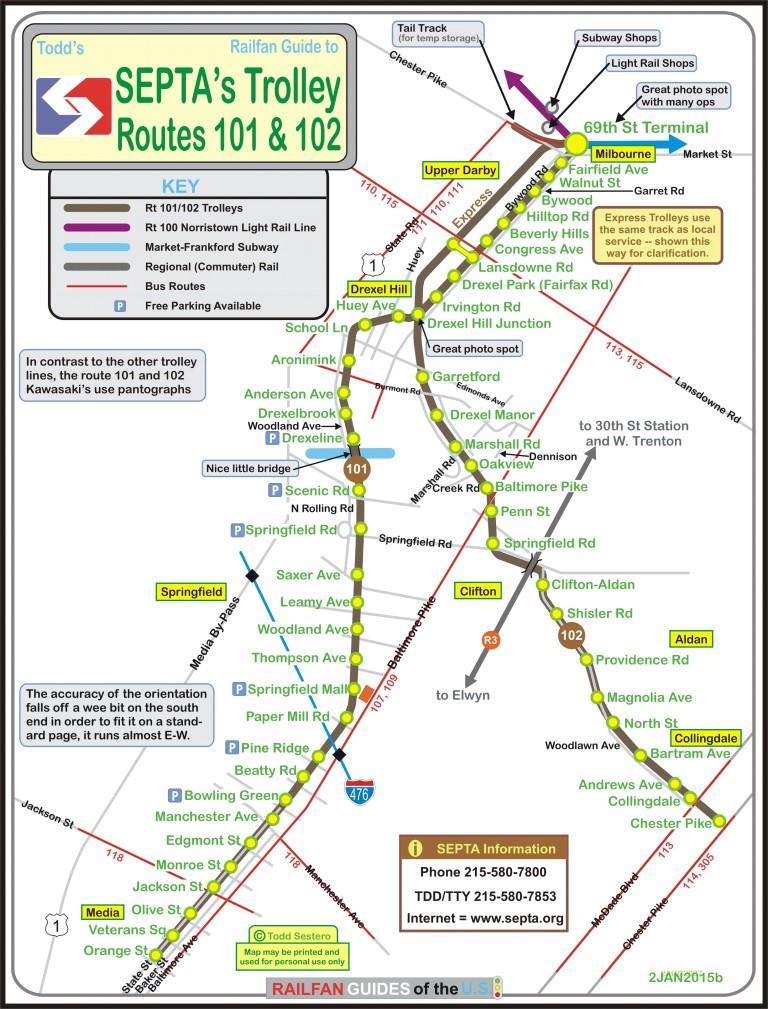
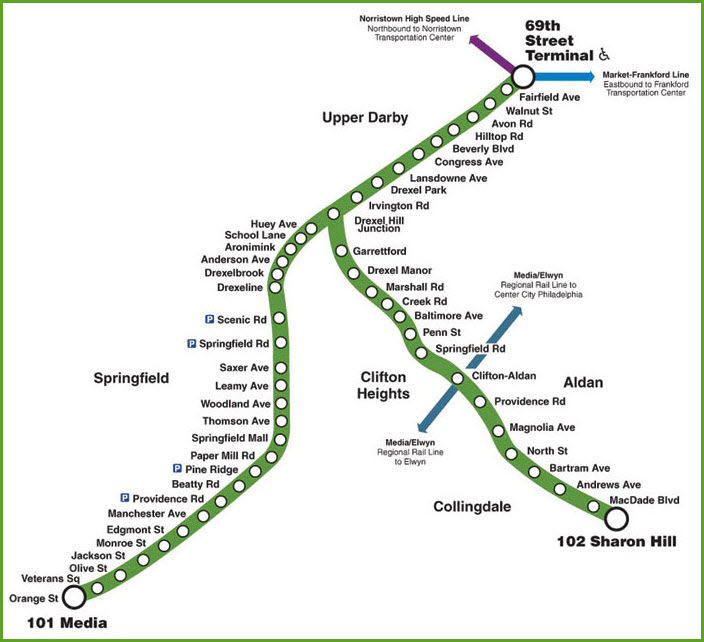
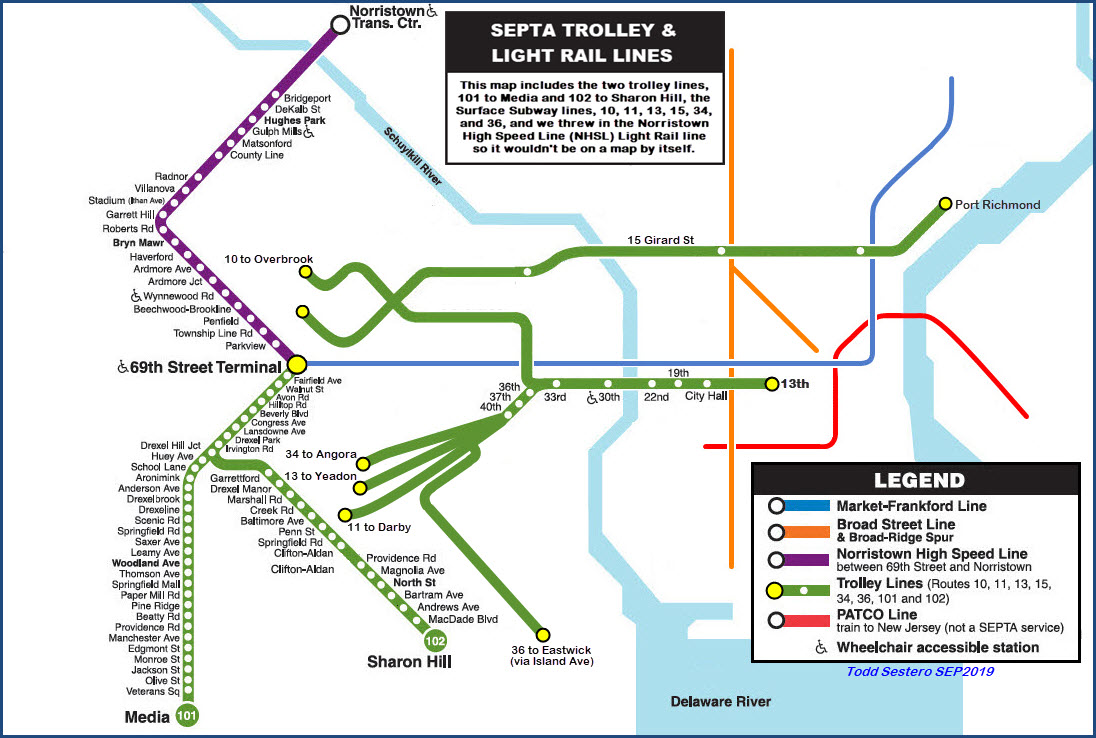
The Red Arrow lines 103 and 104 were discontinued in the 1980's. Routes 101 and 102 are the Red Arrow survivors!
PDF here
Inside, of course
Two cars "headin into the barn".
Car #120 waiting to be dispatched.
Car #128 coming into the terminal.
Cars waiting to go into active service, coming from the yard area.
Car #112 waiting to head out.
Car #112 finally gets the go-ahead.
A couple of cars coming into 69th St.
After the split headed to Media.
An inbound and outbound car at Drexel Hill.
Car #101 approaching the split, coming in from Sharon Hill.
Outbound car approaching the split.
Looking towards 69th St from the Media branch.
In Media
At the end of the line in Media, don't you love the way the rails just STOP?!
A rarity in today's over regulated environment.
Car #111 inbound to 69th St.
Car #120 coming into Media.
Picture by John Engleman, 31DEC2015, around 00:30... OK, so it's technically 1/1/2016 :-)
Even tho the car says it's a 34 line car, it's at the end of the 102 line at
Chester Pike. The car is "wrapped" in the former
Red Arrow paint scheme, and also
bears the number 38 on the car, (on this side - to the left of the "front" doors, under the
sill between the first two windows), in honor of the first car to reach
Media back in the very early 1900's. The wrap is supposed to be
removed within the next three months or so (as of 1/1/16). From the CERA website:
To help celebrate 100 years of trolley service
to Media, Pennsylvania, the Friends of Philadelphia Trolleys sponsored a
fantrip on May 5, 2013 using a pair of Kawasaki LRVs. (Once the “new kids on
the block,” these are basically updated PCC-type cars, and have 33 years of
service with no end in sight.) SEPTA helped give the fantrip a boost by
putting a retro overwrap on car 101, in Philadelphia and West Chester red.
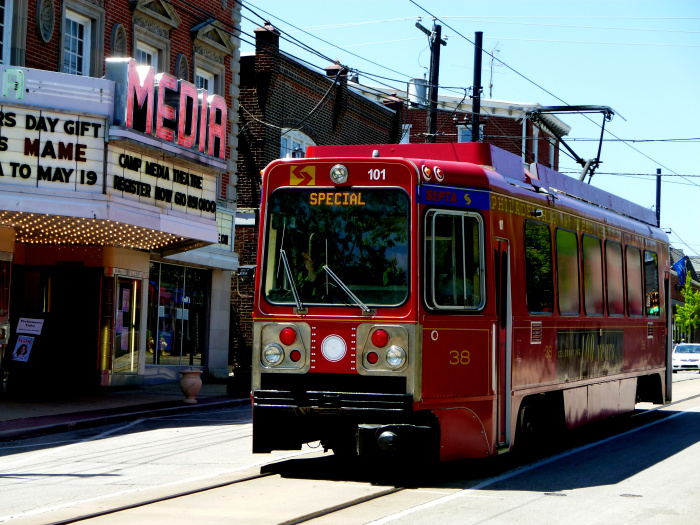
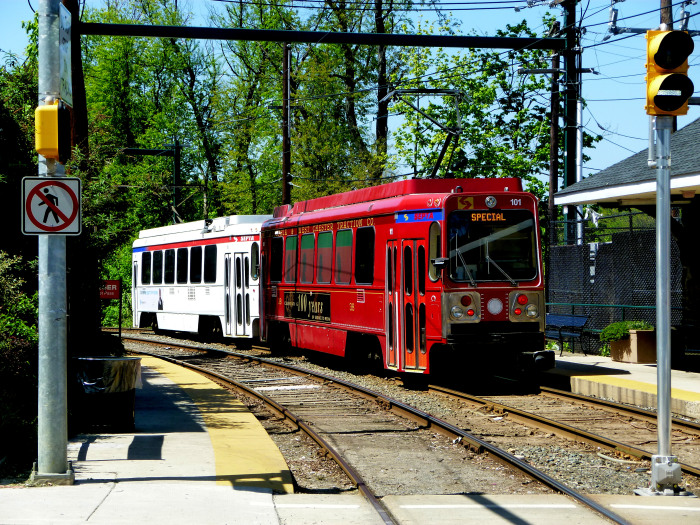
Both photos by David Sadowski from the CERA website and the 2013 fantrip.
Around Hilltop Road.
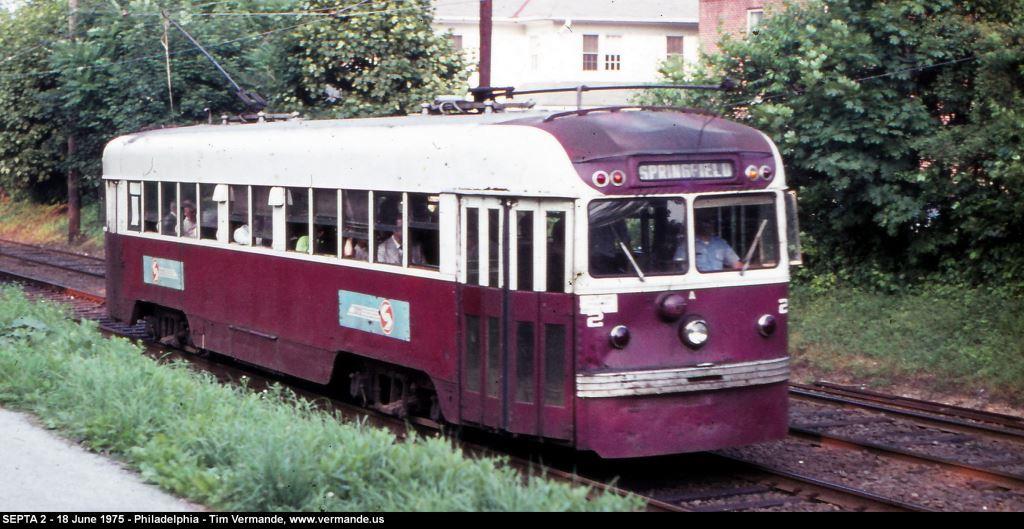 Courtesy Tim Vermande!
Courtesy Tim Vermande!
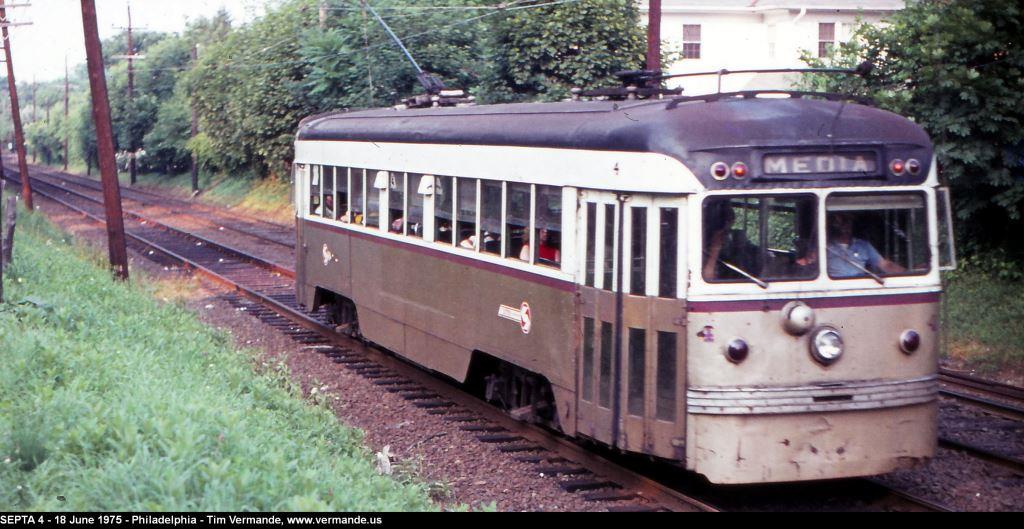 Also courtesy Tim Vermande!
Also courtesy Tim Vermande!
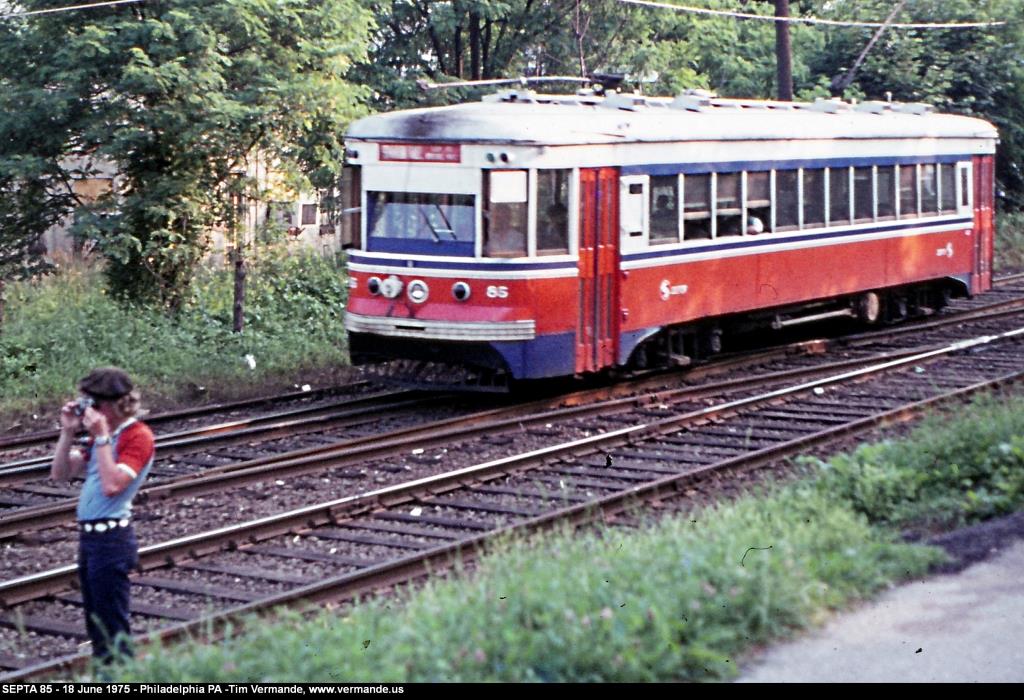 Another one by Tim Vermande!
Another one by Tim Vermande!
Known as an "80" car, these cars were built in 1932 by Brill, and have the same electrical system as 6119 at the Baltimore Streetcar Museum. About half of
these cars were saved.
Signals
The 101
and 102 lines employ a mixture of signals. Most of them are colorlight
signals. Around the 69th St Transportation Center, they are all over the
place because of the interlocking and crossovers. Once the trolleys get
out on the main line, they use bar signals to avoid confusion with regular
street signals for vehicular traffic (this is for the sake of car drivers and
not the operators). Both high and dwarf signals are used when appropriate.
Some of the colorlight signals are 3 aspect, and others are 2 aspect.
Vehicular warning lights at Drexel Hill Junction.
Looking towards 69th St at Drexel Hill Junction.
Looking towards the 69th St Transportation Center from the other side of Market
St.
Bar and colorlight signals near 69th St.
Bar and colorlight signals on the mainline.
Signal S90 at the end of a passing siding.
Bar signals displaying clear, adjacent to a grade crossing where the signals
could be seen by vehicular traffic.
Bar signal and an inbound train around Hilltop Road.
A typical two color intermediate signal on the mainline.
Signals seen from the starting position at 69th St.
Disclaimers:
I love trains, and I love signals. I am not an expert. Period! I do this stuff to have fun and keep from getting bored :-)
Please Note: Since the main focus of my two websites is railroad signals, the railfan guides are oriented towards the signal fan being able to locate them. For those of you into the modeling aspect of our hobby, my indexa page has a list of almost everything railroad oriented I can think of to provide you with at least a few pictures to help you detail your pike.
If this is a railfan page, every effort has been made to make sure that the information contained on this map and in this railfan guide is correct. Once in a while, an error may creep in, ooooops!
Pictures and maps are worth a
thousand words, especially for railfanning. Text descriptions only
get you so far, especially if you get lost or disoriented. Take
along good maps.... a GPS is OK to get somewhere, but maps are still
better if you get lost! I belong to AAA, which allows you to get
local maps for free when you visit the local branches. ADC puts
out a nice series of county maps for the Washington DC area, but their
state maps do not have the railroads on them. If you can find em,
I like the National Geographic map book of the U.S..... good, clear, and
concise graphics, and they do a really good job of showing you where
tourist type attractions are, although they too lack the railroads.
Other notes about specific areas will show up on that page if known.
By the way, floobydust is
a term I picked up 30-40 years ago from a National Semiconductor data
book, and means miscellaneous and/or other stuff.
Pictures and additional information is always needed if anyone feels
inclined to take 'em, send 'em, and share 'em, or if you have
something to add or correct.... credit is always given! BE NICE!!! Contact info
is here
Beware: If used as a source, ANYTHING from Wikipedia must be treated as being possibly being inaccurate, wrong, or not true.
RAILFAN GUIDES HOME
RAILROAD SIGNALS HOME
NEW 02/27/2011, 11/22/2016
Last Modified
16-Sep-2019